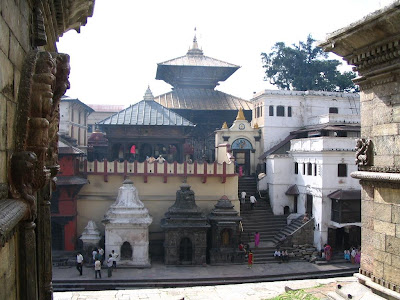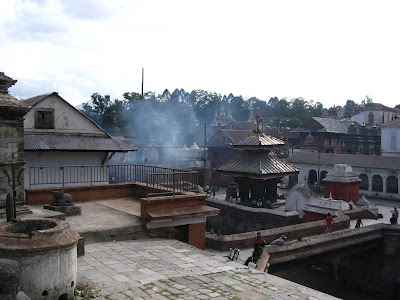Nepal is an wonderful place for so many reasons. I find Kathmandu so fascinating because of the mix of religions. There are many who live here who are Buddhist, there are many whom are Hindu, and still many others fall somewhere in the middle. Yup, Kathmandu has a mix of both; kinda like that chocolate and vanilla cake you see that is swirled together. For an afternoon, adventure we decided to visit Pashupati (or Pashupatinath).
I don't want to pretend that I wrote the following. I am taking it DIRECTLY from "Let's Go: A Let's Go Travel Guide: India and Nepal," St. Martin's Press, 2004, page 826.
"Dedicated to Shiva's incarnation as Pashupati, the gentle Lord of Animals and the guardian deity of Nepal, the temple complex of Pashupatinath, east of Kathmandu, is the holiest Hindu site in Nepal and the countrie's largest shrine complex. In addition to the bathers who dip in the Bagmati on auspicious full-moon nights and on the 11th day after them, thousands of sadhus and Hindu pilgrims descend upon Pashupatinath during the full moon of late February or early March for the Shivaratri festival, a celebration of Shiva's birthday. A full day of carnivalesque festivities - and one of the most boisterous festivals of its kind on the Indian subcontinent - the celebration embraces marijuana-smoking and nudity on the part of the sadhus."
"The Pashupati Temple, built in 1696, rests on the banks of the Bagmati. The brass backside of an enormous statue of Nandi can be seen from the entrance, but the rest of the temple is out-of-view and out-of-bounds for non-Hindus. Other viewpoints in the area afford over-the-wall glimpses of the gold-roofed pagoda. Away from the river and across from the main road is a cluster of five towering white cupolas know as Panch Dewal, whose compound has become a social welfare center. Biddha Ashram, operated by Mother Teresa's Missionaries of Charity, welcomes walk-in volunteers to help clients of the compound's hospice with basic domestic chores."
"Two footbridges span the river. Between them on the near (west) bank is the 6th century Bacchareswari Temple, reportedly once the site of human sacrifice during Shivaratri festivals. Eight ghats and precipitous stone walls line the river. Still frequently used for 15 or so daily cremations, the smouldering ghats are aligned in caste order. The northernmost ghat is reserved for royal cremations, and the next is for political and cultural figures. Be sensitive about photographing the ghats during cremations."
Remember kiddies, Aaron didn't write that. The words and text came from "Let's Go: A Let's Go Travel Guide: India and Nepal," St. Martin's Press, 2004, page 826.
What Aaron does know about Pashupati - it is a UNESCO world heritage site. Muy important!
 Momma and tiny baby.
Momma and tiny baby. Monkeys hanging out.
Monkeys hanging out. The main temple area.
The main temple area. The smoke you see in the background is from one of the ghats (cremation areas).
The smoke you see in the background is from one of the ghats (cremation areas). I don't know how to write this so it doesn't sound morbid... Over to the left is a deceased person wrapped in a beautiful turmeric colored cloth. There are flowers around him, a candle, and incense burning. In a few minutes a pyre will be constructed upon which the body will be placed. There are people everywhere watching what is going on even though they have no connection to the deceased. A few feet away, kids are swimming in the river and people are mingling on the steps. None of it seems disrespectful or innapropriate. Without any negative connotation, people simply gather here just to watch what is going on. (I like this picture because the monkeys are sitting watching the people! Is this what you call people watching?)
I don't know how to write this so it doesn't sound morbid... Over to the left is a deceased person wrapped in a beautiful turmeric colored cloth. There are flowers around him, a candle, and incense burning. In a few minutes a pyre will be constructed upon which the body will be placed. There are people everywhere watching what is going on even though they have no connection to the deceased. A few feet away, kids are swimming in the river and people are mingling on the steps. None of it seems disrespectful or innapropriate. Without any negative connotation, people simply gather here just to watch what is going on. (I like this picture because the monkeys are sitting watching the people! Is this what you call people watching?)









No comments:
Post a Comment